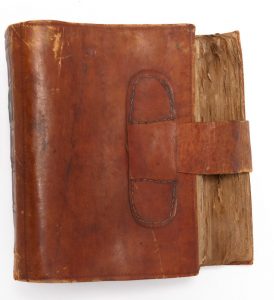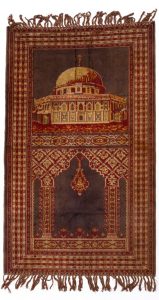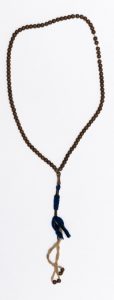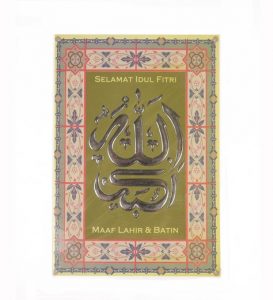Ramadan is a month of great religious significance in the Islamic faith – one of the holiest times of the year. Occurring in the ninth month of the lunar calendar, Muslims abstain from food and water during daylight hours to bring about a nearness to Allah and to exercise discipline. At the end of the month, families and friends gather to eat, give to charity and rejoice as part of the Eid celebrations.
What is Ramadan?
Ramadan, the ninth month of the Islamic calendar, is a holy time for Muslims. It is celebrated as the month in which the Holy Qur’an was sent down from heaven to the Prophet Muhammad.

A Qur’an bound in leather from the Horniman collections
When is Ramadan?
Ramadan begins at the first sighting of the crescent moon in the ninth month. In 2024, it was observed on Sunday 10 March, and will last until the sighting of the new moon which indicates the start of the next lunar month. This year Ramadan is predicted to end around Tuesday 9 April.
As Ramadan is based on the lunar calendar, the dates of the celebration shift forward by ten days each year. In 2025, the holy month will begin on 28 February, and ten days earlier the year after that. This is because the lunar calendar is ten days shorter than the solar year. So, over the course of approximately one 40-year period, Ramadan will be experienced in each of the four seasons.
In turn, the shifting dates influence the duration of each daily fast – during the British wintertime, a fast can last up to 10 hours, while in the summer months, a fast can last up to 17 hours. The same is true geographically – if Ramadan falls in winter in the Southern Hemisphere, it will be in summer in the Northern Hemisphere, for example.
How is Ramadan celebrated?
Throughout the month of Ramadan, most Muslims abstain from food and water between dawn and sunset. Sawm – the Arabic word for fasting which means ‘to abstain’ – is considered a private act of worship between the fasting person and God – as Allah would know if they had eaten in secret. Fasting is also regarded as a form of spiritual discipline, allowing the faithful to devote themselves to prayer, and as a way of empathising with those less fortunate. Children, the elderly, pregnant women and those who are unwell or travelling do not have to fast.
During Ramadan, it is common to have just one meal before dawn – this is known as the Suhoor – and the fast is broken after sundown with a meal called the Iftar. These meals are typically eaten with family or the local community, and visits to friends and relatives often occur following the Iftar.

A prayer mat from Jordan, depicting a Masjid woven in red and purple thread
Many Muslims will try to give up bad habits during Ramadan, instead focusing on Salat – or prayer – and good deeds. Many people also try to read the whole Qur’an at least once during the holy month, and masjids, or mosques, run special gatherings such as religious talks with guest speakers, classes to help recite the Qur’an melodically and applying its pronunciation rulings. In addition to the five daily prayers that are part of the core of Islam, Muslims perform the Tarawih prayer (night prayer) each day of Ramadan.

A tasbih, or string of prayer beads, used by Muslims in the recitation of prayer
What happens at the end of Ramadan?
Muslims are encouraged to seek a special night in Ramadan called Laylat al-Qadr. They seek this through its signs, which include the moon looking like a piece of a bowl on a calm night. Many seek Laylat al-Qadr on odd-date nights in the last 10 days of Ramadan. Laylat al-Qadr is sometimes also referred to as the Night of Power. It is believed that the Prophet Muhammad first received the Holy Qur’an on this day. Laylat al-Qadr is marked with solemnity, devotion and prayer.

In the last few days of the fast, many give Zakat al-Fitr, or a charitable donation, to help those less fortunate join the celebrations to mark the end of Ramadan. Even while rejoicing, Muslims are encouraged to be mindful of families within the wider community who might be struggling.
The end of Ramadan is marked by a celebration called Eid al-Fitr, also known as the ‘festival of breaking the fast’. Traditions vary in the ways Eid is celebrated around the globe, but it is a time for family and friends to come together and rejoice with food and drink, to give each other gifts and dress in new clothes, and to visit the graves of loved ones. Giving thanks to Allah is a core tenet of Eid celebrations, and on the morning of Eid, Muslims offer a special prayer called the Salat al-Eid (Eid prayer).
On Eid morning, many Muslims dress in their best, often new, clothes to attend the Eid prayer. Eid prayers usually take place in a large open space, such as a park. More recently in Britain, these celebrations have been referred to as ‘Eid in the park’. After the prayer, people will stay to eat together, and there are often fun fair rides, bouncy castles and stalls selling sweets to entertain children. The Eid in the park gathering closest to the Horniman Museum has previously taken place in Mountsfield Park in Lewisham.
Many also decorate their houses to celebrate the occasion. People greet one another by wishing an ‘Eid Mubarak’, which means ‘blessed Eid’. Hugs are exchanged to engender unity and good will, and families visit relatives throughout the day, to eat together and give thanks.

A greetings card from Indonesia, celebrating Eid and the end of Ramadan, from the Horniman collections
What symbols, food and objects are associated with Ramadan?
Dates are often eaten for Iftar, the meal to break the fast at the end of the day, and sometimes for the morning Suhoor. Not only are dates a smart choice to quickly replenish energy lost throughout the day’s fast, but they also carry religious significance. It is said that the Prophet Muhammad broke his fast with dates and water each night of Ramadan, and many Muslims choose to do so too.
In some Muslim cultures, lanterns are associated with Ramadan. In what is thought to be a more modern association, lanterns are used to decorate rooms, houses and streets. One possible explanation for their significance is that the traditions of Ramadan – and the meals at the start and end of the day – take place in darkness, so lanterns have been used historically to illuminate the gatherings.
Elsewhere, such as in the cities of Damascus in Syria and Istanbul in Turkey, Ramadan drummers can sometimes be found. They uphold a historic tradition of walking the streets in the early hours of the morning – with the aim of waking people before dawn so they have time to eat ahead of the day of fasting. As a global religion, Islam encompasses many cultures and practices, so there is no one way for Ramadan to be celebrated and observed.


